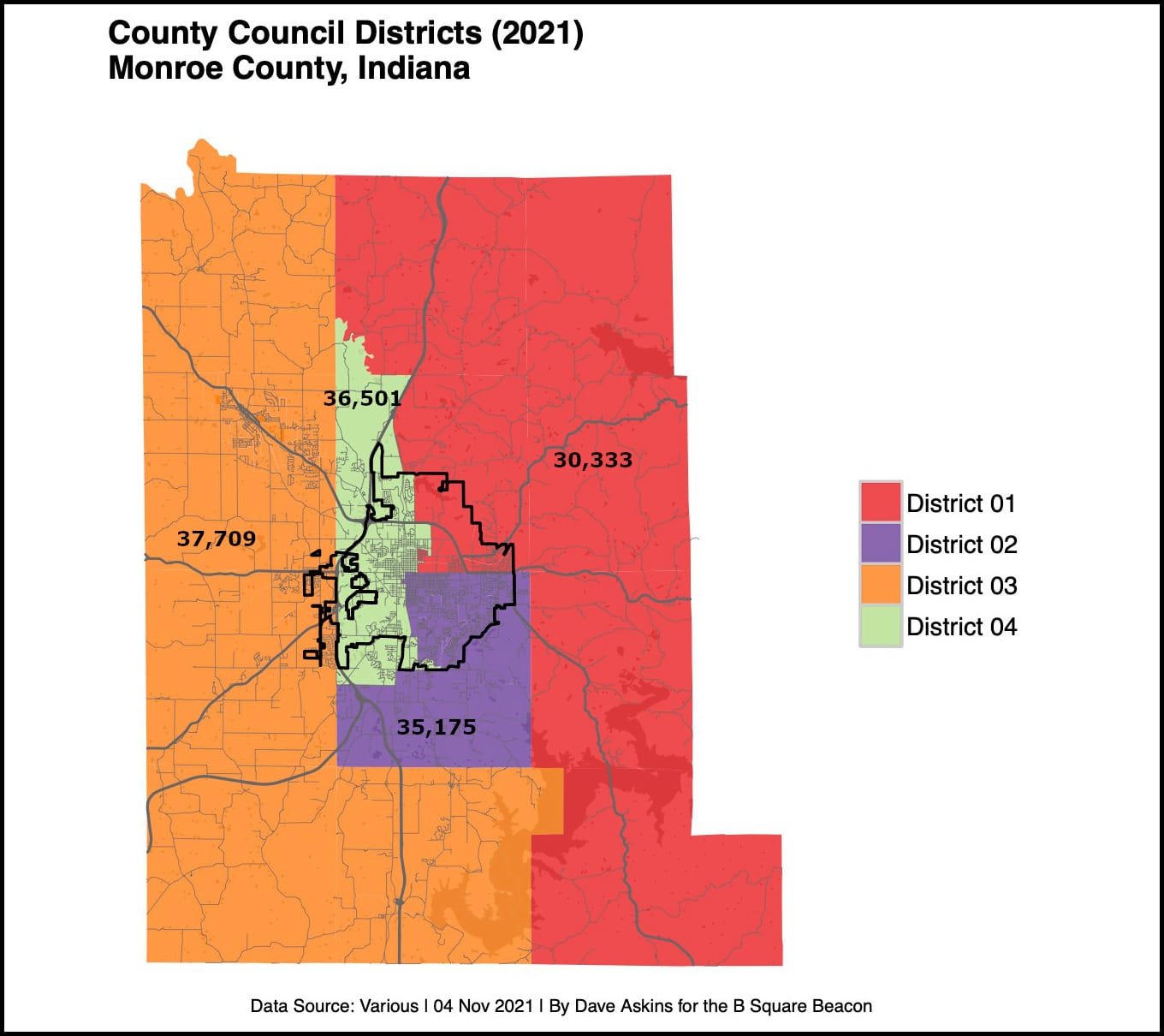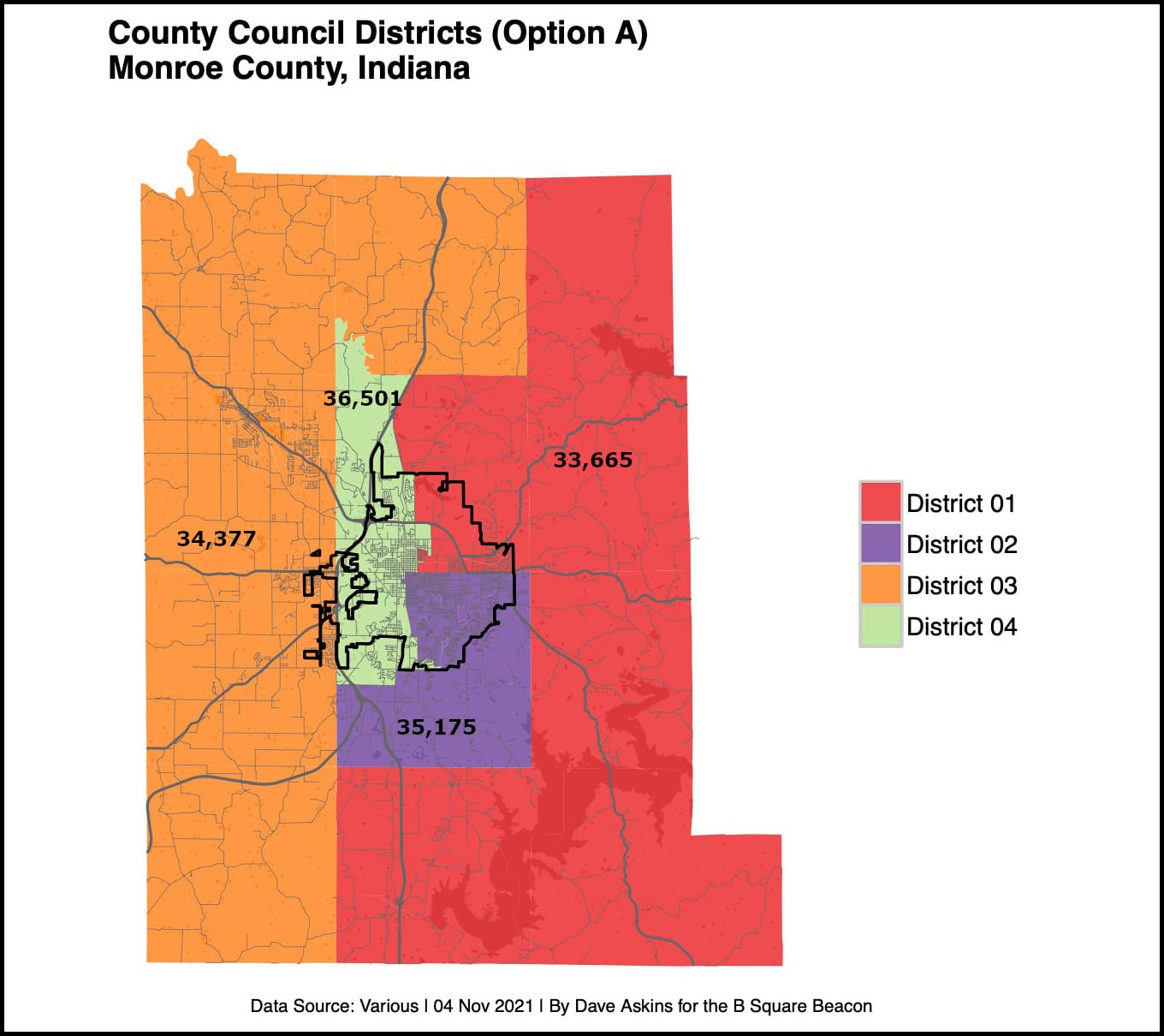Monroe County redistricting committee takes first look at new county council districts, change to Spoonmore’s District 4 seems unlikely




When the Democratic Party’s caucus picks a replacement for the resigning county councilor Eric Spoonmore sometime before year’s end, the relevant council district boundaries will be the same as they are now.
But potential caucus candidates might have some concerns about possible upcoming boundary changes, which could redistrict them out of their caucus-filled seat, preventing a run for election in 2022.
Any worries along those lines can probably be put to rest, based on the initial discussions at Thursday’s meeting of a four-member redistricting advisory committee.
Members of the committee are Regina Moore, Ed Robertson, Joyce Poling, and Hal Turner.
Committee members don’t seem to be looking at Spoonmore’s District 4 as a place where they need to tinker with boundaries in order to balance out the population of the four districts.
But the districts are now out of balance, according to the 2020 census—with a low of 30,333 for District 1 and a high of 37,709 for District 3.
District 4’s population of 36,501 is sandwiched between those two extremes, and is already pretty close to the number that would result, if the county’s total population of 139,718 were divided evenly across the four districts. Distributing the county’s 139,718 residents in a perfectly uniform way would make four districts with populations of about 34,929.
County attorney Jeff Cockerill told committee members on Thursday that the districts are supposed to be balanced in population “as nearly as possible.”
On Thursday, the committee spitballed a couple of different approaches to balancing out the district populations.
Committee member Ed Robertson suggested that District 3 could trade Clear Creek Township in the south to District 1, in exchange for Washington Township in the north. The more populous Clear Creek would net District 1 a total of 3,332 more residents. (That’s labeled “Option A” in the graphics accompanying this article.)
The idea of a “township trade”—instead of transferring some individual precincts—was motivated by the principle that county county districts shouldn’t cross township lines, if that can be avoided.
Committee member Hal Turner expressed some uncertainty about the approach of trading townships. Turner said the committee should think carefully about transferring areas from one district to another, where there is a “commonality of constituent interests.” Turner said any boundary changes should not impact “identifiable groups, like rural versus urban, by diluting them through movement.”
Turner made an alternate proposal for re-balancing the districts that leaves Washington Township out of the mix. Turner suggested transferring just the two eastern precincts of Clear Creek Township to District 3. (That’s labeled Option B in the graphics accompanying this article.)
The two options have close to the same statistical effect. Option A shifts the numbers by 3,332. Option B shifts the numbers by 3,209.
| Pop Current | Pop Option A | Pop Option B | |
| District 1 (red) | 30,333 | 33,665 | 33,542 |
| District 2 (purple) | 35,175 | 35,175 | 35,175 |
| District 3 (orange) | 37,709 | 34,377 | 34,500 |
| District 4 (green) | 36,501 | 36,501 | 36,501 |
| (Max-Min)/AVG | 21.12% | 8.12% | 8.47% |
| Total | 139,718 | 139,718 | 139,718 |
Between now and Monday, when they next meet, committee members want county GIS specialist Jared Eichmiller to prepare clean maps showing the two options for shifting population between council districts.
Also for Monday’s meeting, committee members want to see some options laid out for transferring population among the county commissioner districts—focused on the northern precincts of Perry Township. The three commissioner districts are also now unbalanced as a result of the 2020 census.
Based on the 2020 census, the populations of the three districts break down like this: District 1 (48,147); District 2 (42,133); and District 3 (49,438). The relatively smaller population for District 2, which includes much of the city of Bloomington, is probably due to the decrease in Bloomington’s population, as measured by the 2020 census.
The state’s election division wants council district and commissioner district recommendations from Indiana’s 92 counties by Dec. 26.
The committee’s recommendations for some changes to precinct boundaries were reviewed by county commissioners at this week’s Wednesday meeting. They’re set to vote next Wednesday, Nov. 10 ahead of the state’s Nov. 12 deadline for precinct boundary changes.
Precincts have to get settled before districts, because precincts are the basic building blocks for districts.
The committee’s work and the votes by county commissioners on new boundaries is coming on a compressed timeline compared to previous years, because of the ripple effect of the late 2020 census. The late timing for release of 2020 census numbers led to a late start for state legislators on their work to redraw state-level boundaries.
It was not until Oct. 4 when Indiana governor Eric Holcomb signed off on the new state legislative districts.





Comments ()